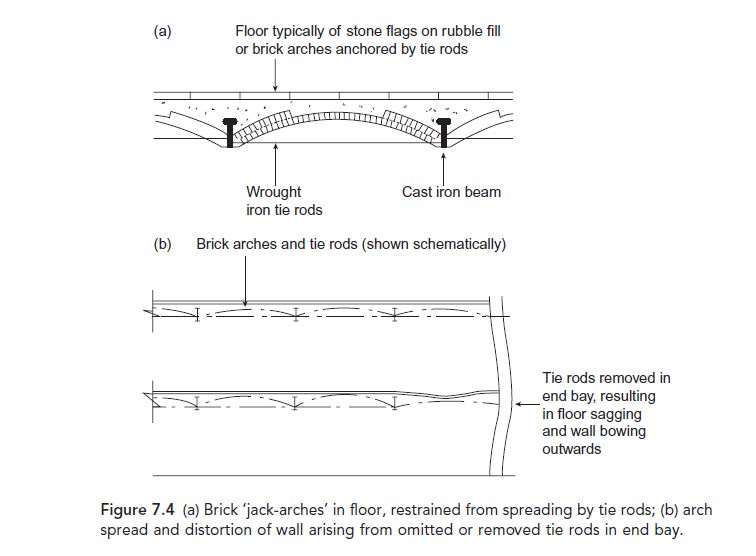While at a converted mill, the owner had me take a look at two unrelated areas both of which made me sweat and curse. One is a jack arch slab supporting an inhabited floor. The arches span between beams at 36" on center (presumed steel "S" beams) and are reinforced in the transverse direction with some sort of bar painted black near the mid point of the arch. My immediate take was that it was a rod with threaded end reinforcing the system against spread and providing some load transfer transverse to the arches. The ends of the rod(s) are not visible. The sequence of arches terminates into a multi-wythe brick masonry wall atop a newer steel beam. There is substantial bulging of the masonry wall near mid arch height (maybe the top of the old steel joist beams). See the attached picture.

They have had the brick work repaired within the last few years and it's already pushing out more than an inch. The single worst course is out 3/4" inch, and the wall angles and bulges more than that. The area is now cordoned off.
My current thoughts are that the threaded rod has failed and that the arches, especially the terminal arch, are pushing out the wall, or that there is a connector such as plate washer and nut in the brick work which is rusting and the foliation is pushing the wall. I have told the owner that they need a letter saying that there is a problem from me and then to cut open the building to see what exactly the problem is. I'll say to shore the area, and am concerned that they need to buttress.
I have been trying to find basic guidance for inspection and repair of this problem, as this was a common system in the 1800s and is still used in some areas (apparently including Iran). I presume this to be a common enough failure mode that there is a standard answer, but the internet just drones on about seismic capacity of these systems. Does anyone have any resources they would recommend or advice?

They have had the brick work repaired within the last few years and it's already pushing out more than an inch. The single worst course is out 3/4" inch, and the wall angles and bulges more than that. The area is now cordoned off.
My current thoughts are that the threaded rod has failed and that the arches, especially the terminal arch, are pushing out the wall, or that there is a connector such as plate washer and nut in the brick work which is rusting and the foliation is pushing the wall. I have told the owner that they need a letter saying that there is a problem from me and then to cut open the building to see what exactly the problem is. I'll say to shore the area, and am concerned that they need to buttress.
I have been trying to find basic guidance for inspection and repair of this problem, as this was a common system in the 1800s and is still used in some areas (apparently including Iran). I presume this to be a common enough failure mode that there is a standard answer, but the internet just drones on about seismic capacity of these systems. Does anyone have any resources they would recommend or advice?

